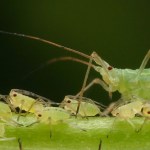aphids
Acyrthociphon pisum, the Pea Aphid
The genome sequence of the pea aphid Acyrthosiphon pisum was published today in PLoS. Concurrently, a set of supporting papers has come out in Insect Molecular Biology. This genome is significant for a number of reasons- it's the first Hemipteran genome to be sequenced, aphids have an unusual reproductive cycle, and this particular species is a serious agricultural pest.
I've not had time to fully digest the paper, but it seems the salient features of this genome are:
extensive gene duplications
a higher gene count than most other known genomes (including…
Formica integroides wood ants tending pine aphids (California, USA)
Photo details: Canon MP-E 65mm 1-5x macro lens on a Canon EOS D60.
ISO 100, f/13, 1/200 sec, twin flash diffused through tracing paper
Soybean aphids piling up in a spider web
It's been snowing aphids the past few days here in Champaign-Urbana. Trillions of them are drifting across town, settling out on our garden, getting caught in our hair. I've never seen anything like it.
I recently learned that this sternorrhynchan storm is composed of soybean aphids (Aphis glycines). That would explain all the aphid biomass. Illinois is a major producer of soy, and there's no shortage of soy fields around here. Sensing the end of summer, the aphids are moving en masse to their winter host, buckthorn.
Soy has traditionally been…
Viruses and bacteria often act as parasites, infecting a host, reproducing at its expense and causing disease and death. But not always - sometimes, their infections are positively beneficial and on rare occasions, they can actually defend their hosts from parasitism rather than playing the role themselves.
In the body of one species of aphid, a bacterium and a virus have formed a unlikely partnership to defend their host from a lethal wasp called Aphidius ervi. The wasp turns aphids into living larders for its larvae, laying eggs inside unfortunate animals that are eventually eaten from…
Where there are plants, there are almost certainly aphids feeding on them. These ubiquitous insects are banquets for many predators, and some have evolved incredible defences against them. The cabbage aphid, for example, is a walking bomb.
Its body carries two reactive chemicals that only mix when a predator attacks it. The injured aphid dies. But in the process, the chemicals in its body react and trigger an explosion that delivers lethal amounts of poison to the predator, saving the rest of the colony.
The aphids' chemical weapons are stolen from the plants they eat. Far from being…
Autumn is a time of incredible beauty, when the world becomes painted in the red, orange and yelllow palette of falling leaves. But there may be a deeper purpose to these colours, and the red ones in particular. In the eyes of some scientists, they aren't just decay made pretty - they are a tree's way of communicating with aphids and other insects that would make a meal of it. The message is simple: "I am strong. Don't try it."
During winter, trees withdraw the green chlorophyll from their leaves, and textbooks typically say that autumn colours are produced by the pigments that are left…
Imagine that a massive hole appeared in a wall of your house, and you'd decided to fix it yourself. You head over to a DIY store and load up on plaster, tools and paint and look forward to many hard and tedious hours of work. If that seems like a chore, you might get some perspective by considering the plight of the gall aphid Nipponaphis monzeni. When holes appear in their homes, some unlucky individuals are tasked with repairing the damage using their own bodily fluids. They sacrifice themselves for the sake of some DIY.
Some species of aphids are heading towards the incredibly cooperative…
It's a scene straight out of a horror film - you look around and see dead bodies everywhere. They haven't just been killed either, they've been hollowed out from the inside-out leaving behind grotesque mummified shells. What would you do if you were confronted with such a macabre scene? Flee? Well, if you were an aphid, you'd probably just feel relieved and go about your business. Aphids, it seems, find security among the corpses of their peers.
Aphids, like almost all insects, are the targets of parasitic wasps that implant eggs inside their bodies. On hatching, the wasp grubs use the aphid…
This morning I was picking through recent ant literature for a 2008 myrmecological retrospective post when I stumbled on this little gem.
Why do autumn leaves change to such striking colors? Kazuo Yamazaki thinks it's all about the ants:
Therefore, bright autumn leaves may have adaptive significance, attracting myrmecophilous specialist aphids and their attending ants and, thus, reducing herbivory and competition among aphids.
I hereby proclaim Kazuo Yamazaki the first recipient of an award in his own name, the Yamazaki "Going Way Out On A Limb" Award, for creative lateral thinking in…
I can't imagine a more unpleasant way to go. This poor oleander aphid (Aphis nerii) has its innards sucked out by a hoverfly larva.
photo details: Canon MP-E 65mm 1-5x macro lens on a Canon 20D
f/13, 1/250 sec, ISO 100
MT-24EX flash diffused through tracing paper
levels adjusted in Photoshop.
